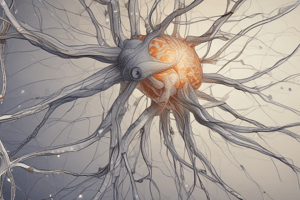Podcast
Questions and Answers
Which of the following correctly describes the relationship between grey matter and white matter in the brain?
Which of the following correctly describes the relationship between grey matter and white matter in the brain?
- Grey matter is located on the outside of the brain, and white matter is found on the inside. (correct)
- Grey matter is composed exclusively of glial cells, and white matter consists of pyramidal neurons.
- Grey matter contains neuronal tracts, while white matter contains cell bodies.
- Both grey and white matter are primarily composed of axons.
What conclusion did Galen draw from his dissections of gladiator brains?
What conclusion did Galen draw from his dissections of gladiator brains?
- All brain functions rely on the heart as the main organ.
- The cerebellum is responsible for cognitive processing.
- The cerebrum plays no role in sensory perception.
- The density of the cerebellum indicates its role in muscle control. (correct)
Which statement accurately reflects the contributions of Ramon y Cajal to neuroscience?
Which statement accurately reflects the contributions of Ramon y Cajal to neuroscience?
- He was the first to describe the blood-brain barrier.
- He introduced the idea that all neurons are identical in structure.
- He identified the concept of the brain as a pumping mechanism.
- He utilized dyes to demonstrate the diversity of neuron types. (correct)
Which of the following areas corresponds correctly to its associated brain function as defined by Brodmann areas?
Which of the following areas corresponds correctly to its associated brain function as defined by Brodmann areas?
What was Hippocrates' belief about the centers of intellect compared to Aristotle's view?
What was Hippocrates' belief about the centers of intellect compared to Aristotle's view?
Which scientist first determined that different parts of the brain are responsible for specific functions through experiments with patients?
Which scientist first determined that different parts of the brain are responsible for specific functions through experiments with patients?
What is the primary role of glial cells, as described in the content?
What is the primary role of glial cells, as described in the content?
Which morphogen is mentioned as inducing motor neuron cell fate in the neural tube?
Which morphogen is mentioned as inducing motor neuron cell fate in the neural tube?
What discovery did the 1881 conference highlight regarding motor functions in the brain?
What discovery did the 1881 conference highlight regarding motor functions in the brain?
Which layers or plates are mentioned as part of the neural patterning process?
Which layers or plates are mentioned as part of the neural patterning process?
Flashcards are hidden until you start studying
Study Notes
Introduction to the Brain Structure
- Brain is divided into cerebral divisions, with nuclei and circuits composed of various cells, including glial cells and pyramidal neurons.
- Two hemispheres characterized by gyri and sulci; the cerebral cortex, particularly neocortex, contains dominant pyramidal neurons controlling motor functions.
- Grey matter (outer layer) comprises cell bodies, while white matter (inner layer) contains neuronal tracts (axons).
- Ramón y Cajal's early 1900s research utilized dyes to reveal the diverse types of neurons.
- Brain anatomy is categorized into 52 Brodmann areas, e.g., areas 1, 2, and 3 for somatosensory cortex, area 39 for language processing, and Wernicke’s area (Brodmann 22).
- Ancient Egyptians likened neurons to the Nile River; cognitive functions previously attributed to the heart by Aristotle, later countered by Hippocrates.
- Galen, through gladiator brain dissections, theorized the cerebellum's role in muscle control and cerebrum's role in sensory perception, associating muscle actions with “animal spirits.”
- René Descartes posited the pineal gland as the interaction point for mind and body, linking consciousness with physical presence.
- Paul Broca identified specific brain regions for distinct functions in the 1850s, notably Broca's area linked to speech production, through studies on patients with left hemisphere lesions.
- Camillo Golgi advanced understanding of single neuron structures using silver stains in the 1890s, aiding Ramón y Cajal in developing the neuron doctrine.
- Glial cells serve as support ('glue'); astrocytes regulate neurotransmitter activity and maintain blood-brain barrier integrity, while microglia act as immune cells, involved in synaptic pruning.
Development of the Brain Cortex
- In the 1860s, Paul Broca's research on aphasia linked damage in specific brain areas with speech production deficits.
- Wernicke's area, critical for language expression and comprehension, identified in the temporal lobe.
- An 1881 conference concluded against strict localization of motor functions after observing dogs and chimps, advancing the concept of functional localization.
- The brain develops from the neural tube, which forms primary and secondary brain vesicles that split into six distinct parts through morphogenesis.
- Neuroepithelium, a single cell layer around the ventricular system, appears multi-layered due to migration along the apical-basal axis during different cell cycle stages.
- The rostral end of the neural tube divides into the prosencephalon, mesencephalon, and rhombencephalon.
- Morphogens are signaling molecules that dictate cellular responses based on concentration, an idea expanded upon by Turing in 1952.
- Cortical expansion is notably greater in primates compared to rodents, enabling the application of rodent studies to human brain function due to similar developmental patterns.
- Organizers release morphogens that influence transcription factors, which in turn determine specific cell fates within the developing cortex.
- Roof plate and ectoderm signal for interneuron fates, while the floor plate and notochord direct motor neuron identities through Sonic Hedgehog morphogen gradients.
- The interaction of multiple organizers in early brain development allows for distinct neural patterning, affecting cell fate via varying morphogen concentrations.
- Secondary organizers emerge in the telencephalon, leading to the commitment of neuroepithelial cells to cortical development.
- Disruption of transcription factor expression in knockout mice alters significant size and boundary changes of brain areas, demonstrating the influence of morphogen gradients on developmental outcomes.
Studying That Suits You
Use AI to generate personalized quizzes and flashcards to suit your learning preferences.




